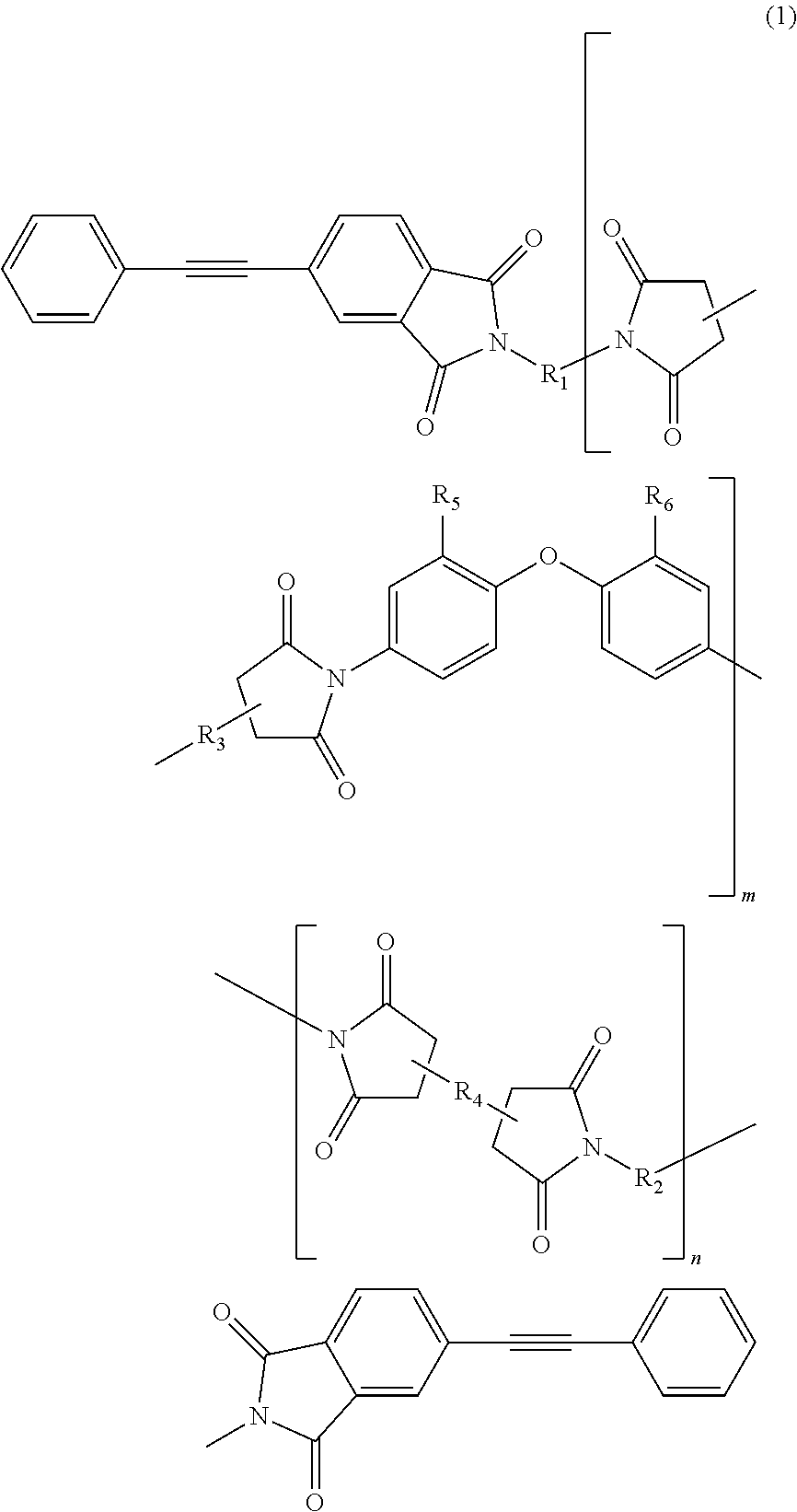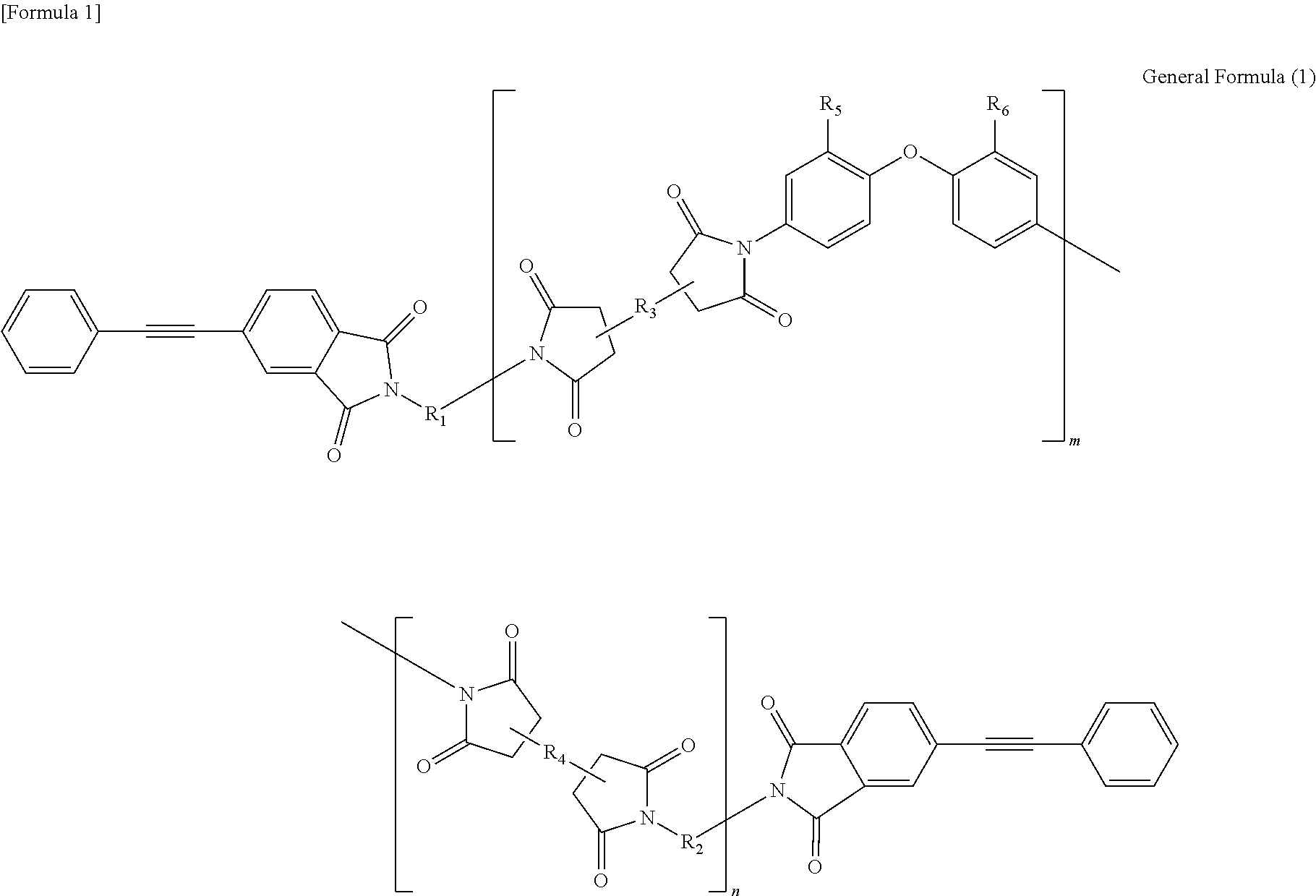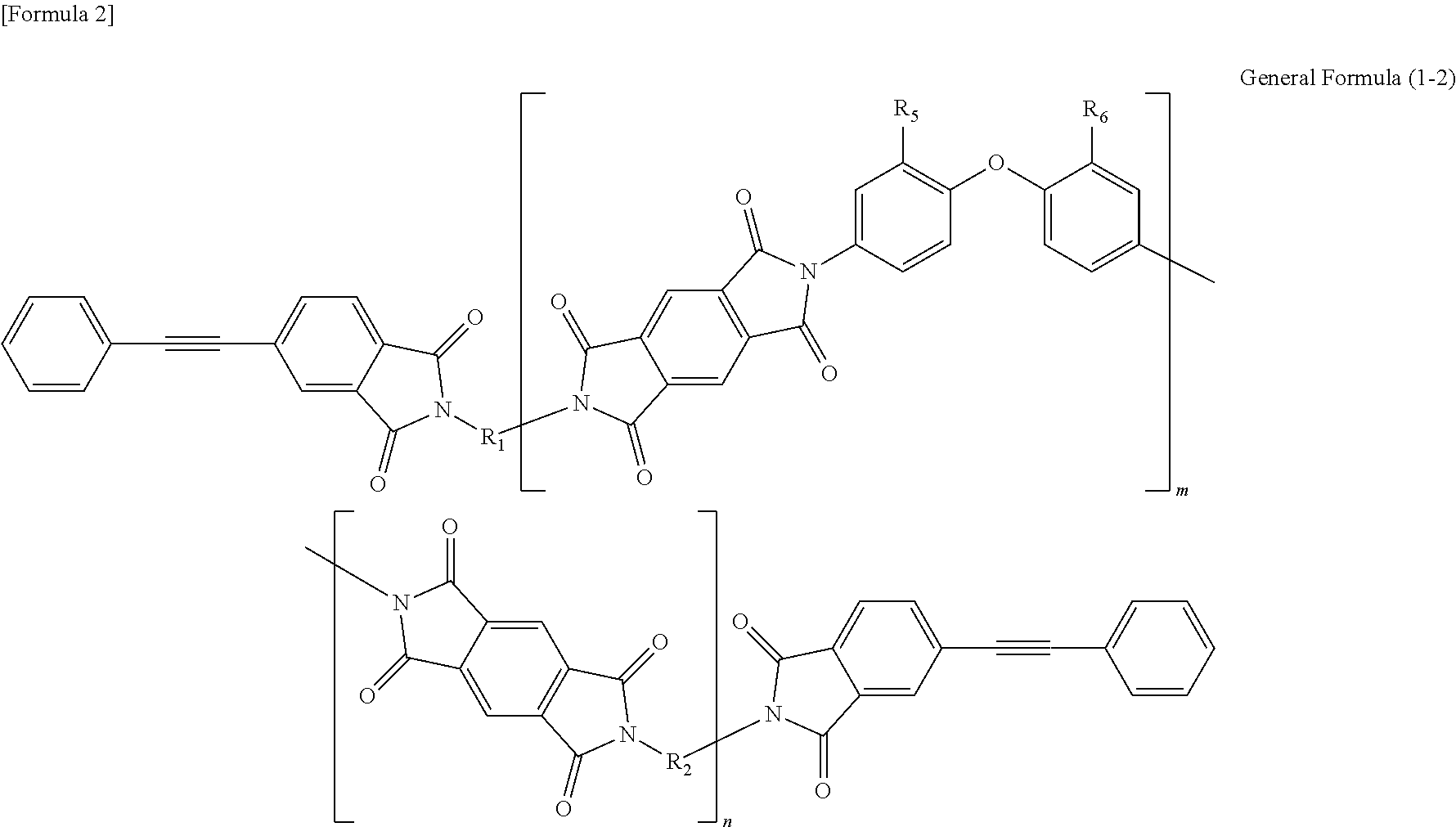Soluble terminally modified imide oligomer using 2-phenyl-4, 4'-diaminodiphenyl ether, varnish, cured product thereof, imide prepreg thereof, and fiber-reinforced laminate having excellent heat resistance
a terminal modification and imide oligomer technology, applied in the direction of synthetic resin layered products, adhesive processes with surface pretreatment, textiles and paper, etc., can solve the problem of terminal modification of imide oligomer, and achieve the reduction of the breaking elongation of the resulting polymer, the structure of the diamine used is made more flexible, and the polymerization degree is lowered
- Summary
- Abstract
- Description
- Claims
- Application Information
AI Technical Summary
Benefits of technology
Problems solved by technology
Method used
Image
Examples
example 1
[0055]2.761 g (10 mmol) of 2-phenyl-4,4′-diaminodiphenylether and 10 mL of N-methyl-2-pyrrolidone were placed and dissolved in a 100 mL three-necked flask equipped with a thermometer, a stirring bar, and a nitrogen-supplying tube; 2.354 g (8 mmol) of 3,3′,4,4′-biphenyltetracarboxylic dianhydride and 2.4 mL of N-methyl-2-pyrrolidone were added thereto; and the mixture was allowed to react in polymerization reaction under nitrogen stream at room temperature for 2.5 hours, at 60° C. for 1.5 hours and additionally at room temperature for 1 hour, to give an amide acid oligomer. 0.993 g (4 mmol) of 4-(2-phenylethynyl)phthalic anhydride was added to the reaction solution; the mixture was allowed to react for terminal modification under nitrogen stream at room temperature for 12 hours and then stirred at 195° C. for 5 hours for imidation.
[0056]After cooling, the reaction solution was poured into 900 mL of ion-exchange water, and the precipitated powder was collected by filtration. The powde...
example 2
[0061]2.071 g (7.5 mmol) of 2-phenyl-4,4′-diaminodiphenylether, 1.332 g (2.5 mmol) of 9,9-bis(4-(4-aminophenoxy)phenyl)fluorene and 10 mL of N-methyl-2-pyrrolidone were placed and dissolved in a 100 mL three-necked flask equipped with a thermometer, a stirring bar, and a nitrogen-supplying tube; 2.354 g (8 mmol) of 3,3′,4,4′-biphenyltetracarboxylic dianhydride and 3.7 mL of N-methyl-2-pyrrolidone were added thereto; and the mixture was allowed to react in polymerization reaction under nitrogen stream at room temperature for 2.5 hours, at 60° C. for 1.5 hours and additionally at room temperature for 1 hour, to give an amide acid oligomer. 0.993 g (4 mmol) of 4-(2-phenylethynyl)phthalic anhydride was added to the reaction solution; and the mixture was allowed to react for terminal modification under nitrogen stream at room temperature for 12 hours and then stirred at 195° C. for 5 hours for imidation.
[0062]After cooling, the reaction solution was poured into 200 mL of ion-exchange wat...
example 3
[0064]1.3807 g (5 mmol) of 2-phenyl-4,4′-diaminodiphenylether, 2.6631 g (5 mmol) of 9,9-bis(4-(4-aminophenoxy)phenyl)fluorene and 10 mL of N-methyl-2-pyrrolidone were placed and dissolved in a 100 mL three-necked flask equipped with a thermometer, a stirring bar, and a nitrogen-supplying tube; 2.354 g (8 mmol) of 3,3′,4,4′-biphenyltetracarboxylic dianhydride and 4.6 mL of N-methyl-2-pyrrolidone were added thereto; and the mixture was allowed to react in polymerization reaction under nitrogen stream at room temperature for 2.5 hours, at 60° C. for 1.5 hours and additionally at room temperature for 1 hour, to give an amide acid oligomer. 0.993 g (4 mmol) of 4-(2-phenylethynyl)phthalic anhydride was added to the reaction solution; and the mixture was allowed to react for terminal modification under nitrogen stream at room temperature for 12 hours and then stirred at 195° C. for 5 hours for imidation.
[0065]After cooling, the reaction solution was poured into 200 mL of ion-exchange water...
PUM
| Property | Measurement | Unit |
|---|---|---|
| Elongation | aaaaa | aaaaa |
| Glass transition temperature | aaaaa | aaaaa |
| Temperature | aaaaa | aaaaa |
Abstract
Description
Claims
Application Information
 Login to View More
Login to View More - R&D
- Intellectual Property
- Life Sciences
- Materials
- Tech Scout
- Unparalleled Data Quality
- Higher Quality Content
- 60% Fewer Hallucinations
Browse by: Latest US Patents, China's latest patents, Technical Efficacy Thesaurus, Application Domain, Technology Topic, Popular Technical Reports.
© 2025 PatSnap. All rights reserved.Legal|Privacy policy|Modern Slavery Act Transparency Statement|Sitemap|About US| Contact US: help@patsnap.com



